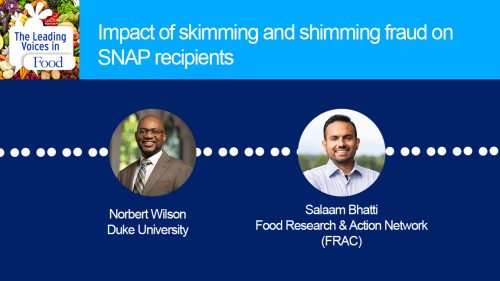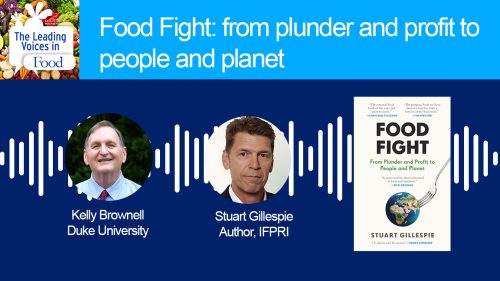The Leading Voices in Food
E19: Martin Bloem – Embrace Complexity to Fix the Food System
One of the most important questions facing the world is how it will feed itself both now and in the future. Answering this question will require the brightest minds; people who will understand the complex interactions of trade, poverty, climate change, agriculture technology, and the ever-changing political landscape from country to country. And this is just a name, some of the factors. Few people are as capable of seeing how all these pieces fit together as our guest Dr. Martin Bloem, professor, and director of the Center for a Livable Future at Johns Hopkins Bloomberg School of Public Health.
Subscribe: Apple Podcasts | TuneIN | YouTube Music | SoundCloud | PocketCasts | Radio Public
Tags: Agriculture & Tech | Food Insecurity | International Food & Ag Policy |

Nutrition expert Martin Bloom holds MD and Ph.D. degrees both from the University of Maastricht in the Netherlands. He joined the Johns Hopkins Center for a livable future in 2017 after serving 12 years in Rome as a senior nutrition advisor at the United Nations World Food Program. His career includes posts spanning the Netherlands, Thailand, Bangladesh, Indonesia, Singapore, and in Italy. He has coauthored and co-edited seven books and more than 100 peer review articles. He has more than three decades of experience in nutrition research and policy and has devoted his career to improving the effectiveness of public health and nutrition programs through applied research.
Interview Summary
The Center for a Livable Future being has been at the very forefront of work on food systems. Can you explain the purview of the center?
We are in the process of strategic planning now. If you look back over the past 23 years, the focus of the center was very much on food systems in the context of the US. So very domestic work looking particularly at the potential negative impacts of the food system on public health, taking a public health lens looking at what happens very close to the food production as well as what the impact would be on consumers. Also, a focus on urban food systems, particularly looking in the context of Maryland and Baltimore food problems. Beyond that actually, I think the last couple of years also there was a shift focusing more looking into the negative impact of agriculture on climate change and what could we do to mitigate those impacts.
You’ve contributed to lots of prestigious and important activities like being on the UN standing committee on nutrition and working with the United Nations in a number of other capacities, and also the World Health Organization. These activities and your own work give you a really very global view on nutrition and the state of the world’s food supply. So do you think we’re making progress globally on combating hunger, food insecurity, and malnutrition?
Yeah, of course. I think we have made quite a lot of progress. But I think we are now, I would say, at a critical point because yes, my background is always in tackling the problem of undernutrition. But of course, we realize that already in the last 10-15 years that the double burden was also an issue. But I think the major shift in thinking started when we as the whole global community started to develop the global goals, the sustainable development goals. Then suddenly you realize that it’s not anymore a problem of low and middle-income countries. As you know, originally the focus was within the Millenium Goals mainly to try to improve the health and nutrition status of low and middle-income countries and people. But actually, with the Sustainable Development global goals it has changed.
We understand very much that in fact, everything’s interlinked. The food system is interlinked, health systems are interlinked. And so if you want to tackle these issues such as climate change, you need to have a global perspective. And so I think that certainly because of that we look very differently at the global nutrition problems. It’s not anymore about that you focus only on stunting, for example, or acute malnutrition or overweight and obesity. I think you have to tackle these problems as complex systems of nutritional issues, as well as all of them, are related, of course, to food systems.
Could you give an example of how things are done differently now given this new view of how the systems connect with one another?
Well, a good example is reporting. So about five years ago, was the first edition of the global nutrition report that instead of just focusing only on undernutrition, I think the World Health Organization, together with the FAO said, okay, let’s focus on all forms of malnutrition. I think that’s already a beginning. When you start to capture all forms of malnutrition as the target instead of only saying, okay, we deal with stunting, you deal with wasting, and the rest of the world will be dealing with obesity. And I think that is a fundamental shift in thinking that took place, and on an annual basis we have this report. But that also started in a way based on a lot of work in the field of undernutrition and stunting particularly. And I don’t know if you know, but in 2008 a Lancet Commission developed the first series on nutrition and that was a very big success.
But it was also clear that if you want to tackle stunting, you need to embrace the complexity again and deal with many different strategies at the same time. But also at that particular time, they had the first longitudinal studies, something about six different countries studies showing that stunting was one of the key determinants of overweight and obesity and chronic diseases in many of these countries. And so just focusing only thinking of the double burden, and only based on the system, it has also had to do with tackling stunting as the first step in trying to prevent over nutrition in the next decade in any of these countries.
After a number of years of progress and the percentage numbers of people in the world who are chronically malnourished declining steadily, for the past three years numbers have reversed and started to go up again. What do you attribute that to?
First of all, as you know, I think the definition of undernourishment is very different than the clinical definition of what they call stunting or wasting. The undernourishment is, in fact, an economic indicator. It doesn’t mean anything about whether people are hungry. It’s based on the food balance sheets. It’s a combination of food balance sheets as well as a poverty adjustment at the country level. So since it’s an economic indicator, it means also that it has much more to do with the food systems and the production side of the food system and not much with the consumer side of the food system. And I think one of the key issues, of course, is that indicator has been influenced by instability in many countries, particularly in Africa and the Middle East.
Is the climate of a problem with this too?
Eventually, of course. Technically speaking as you know, the production of food, of course, will be influenced by climate. There are so many indications that you will have more droughts, more unstable weather, and the El Nino/La Nina effects will be more outspoken I would say. We’ve seen El Nino has had quite some impact in Africa. But I could see that’s one of the factors but that it’s not the only factor. Coming from the World Food Program, we have seen a lot of security issues in the countries is also a key determinant of that shift of the increase. But again, coming back to my point–it has to do with production. If you look the indicator from the perspective of nutrition outcomes, that’s a different indicator. We see there a steady decline in stunting, although the wasting is still very stable. And I think wasting also has to do with the fact that hunger in these countries is more determined by war or internal conflict.
So if the world is producing enough food to feed its people, why is there hunger and food insecurity in the first place? You mentioned war, and political instability is one of the problems. What are some of the others?
It depends again, where you are coming from. A lot of people are always saying, okay, we have enough food in the world, it’s just a matter of distribution. I don’t think that is true. I think from an energy perspective it’s true. So when you look at staple food, yes, I think we have enough staple food at the global level. And that’s why the US produces more and can export more, and so it’s the same case in Europe. But from a quality perspective, I think we are in a different field because I think it’s very clear that stunting is caused by a lack of protein and micronutrients in the early years, in the first 1000 days. And that’s still an issue, major issue in many countries in the world. Low and middle-income countries in Asia or Africa, but also even Latin America and certain groups.
So yes, it is a form of equity issues, poverty issues, but it’s not the only issue. And so the point is that you have to look at energy needs and at quality–quite often the discussion, particularly coming from Rome originally, the focus is always on energy. It’s not for nothing that FAO had undernourishment as the indicator and not quality. But that shift is also changing. It’s very interesting to see it after the last INS meeting a couple of years ago that the language of FAO is also changing. It’s also focusing on micronutrients and proteins and not only focusing on energy.
Given that it’s already difficult to produce enough nutrients to nourish the world, with climate change accelerating and with substantial population growth expected, how much of a challenge do you think it will be to continue to produce enough food?
I’m much more optimistic. I think for me I’m more concerned about the type of diets we are consuming than about whether we can produce enough food. We are just finishing a paper on looking at the impact of varying diets in 150 countries, on climate and is it is very interesting to me that if you look at, for example, in many countries like in the US–we produce more than what we need for a healthy diet. But of course there are other countries–look at India–that still do not produce enough from a quality perspective at a population level. There are other places in the world like Latin America who produce quite a lot, but in fact, there is still a level of undernutrition too because of inequity issues.
So what I liked about our paper is that what we show is that, for example, a healthy diet’s impact on the climate is about the same as if you are an elective vegetarian. People who shift to be elective vegetarian don’t help so much the climate. But if you, for example, do not consume that meat and even if you are still a carnivore, to some extent, the impact on climate is much more dramatic. So for me, what I see working in Asia and in many different places, it is I think more important that we think very carefully: how can we, in fact, reduce the level of stunting in those countries and at the same time create diets which are culturally acceptable as well as good for the climate. And I see a lot of potentials, you know, based on this paper. For example, looking into the diet of Indonesian, with 180 million people and there is still 35% stunting. If they stick to their classical diet and only increase a certain amount of milk production, they can actually do a pretty good job both for the climate as well as reduction of undernutrition and preventing overnutrition. So it’s really interesting. I think, you know, that’s the way we have to look at the world. So thinking about production, looking at under and over nutrition, tackling that at the same time, instead of trying to separate all these different issues as if they are separate problems. But I think you need to embrace complexity by that, and quite often that’s not what people like to do.









